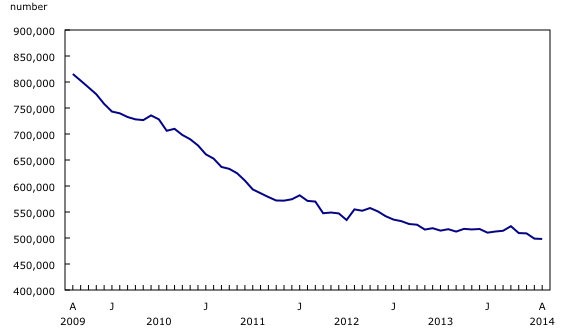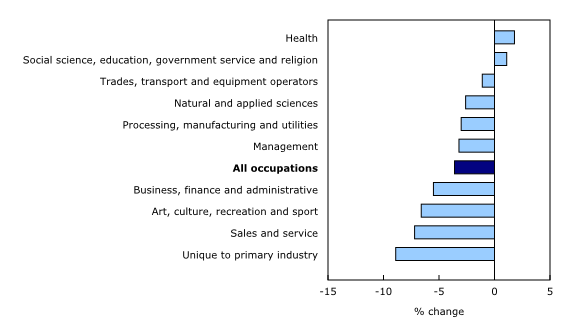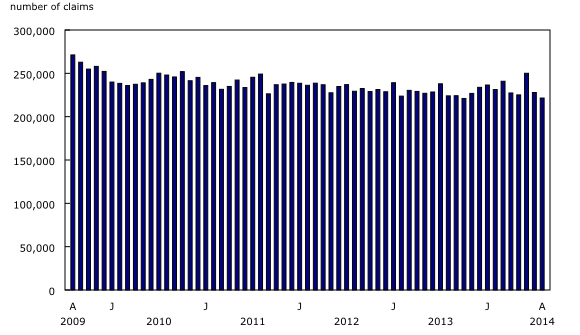Employment Insurance, August 2014
Archived Content
Information identified as archived is provided for reference, research or recordkeeping purposes. It is not subject to the Government of Canada Web Standards and has not been altered or updated since it was archived. Please "contact us" to request a format other than those available.
Released: 2014-10-23
Following a decrease in July, the number of people receiving regular Employment Insurance (EI) benefits in August was essentially unchanged, at 498,100. Compared with 12 months earlier, the number of beneficiaries fell by 18,800 or 3.6%.
In August, both Manitoba and Alberta had fewer beneficiaries. At the same time, Newfoundland and Labrador posted an increase, while there was little change in the other provinces.
The change in the number of regular EI beneficiaries reflects various situations, including people becoming beneficiaries, people going back to work and people no longer receiving regular benefits.
Provincial and metropolitan area overview
In Manitoba, the number of regular EI beneficiaries fell for the second consecutive month (-2.3%) to 12,700 in August. In Winnipeg, the number of beneficiaries was down 4.0%, the third consecutive monthly decrease.
Following a notable decline in July, the number of beneficiaries in Alberta decreased slightly in August (-1.2%) to 28,500. Both Calgary (-2.2%) and Edmonton (-1.7%) had fewer people receiving benefits.
In August, the number of people receiving benefits in Newfoundland and Labrador increased by 1.8% to 30,600, following a marked decline the previous month. In St. John's, the number of beneficiaries was unchanged, after three consecutive months of declines.
While the other provinces saw virtually no change in the number of beneficiaries, this was not the case in some of the metropolitan areas within these provinces.
In August, there were 30,300 people receiving benefits in New Brunswick. The number of beneficiaries rose by 1.7% in Saint John, while it was little changed in Moncton.
The number of beneficiaries in Quebec stood at 146,700 in August. Among the province's six metropolitan areas, Trois-Rivières (+3.4%) and Gatineau (+1.5%) posted increases. At the same time, the number of beneficiaries in the metropolitan area of Québec was down 2.1%. In Montréal, the number of beneficiaries totalled 54,200 in August, down slightly (-1.2%) from July, while there was essentially no change in Saguenay and Sherbrooke.
In August, there were 150,400 people receiving benefits in Ontario. Among the 15 metropolitan areas in the province, Windsor (+4.2%) and Peterborough (+2.0%) posted increases in the number of beneficiaries, while 9 areas recorded declines ranging from 1.0% in Brantford to 3.1% in Greater Sudbury. At the same time, there was little change in the other 4 metropolitan areas, including Toronto, where 57,800 people received benefits.
In British Columbia, 49,600 people received regular EI benefits in August. The number of beneficiaries increased 4.0% in Abbotsford–Mission, while it decreased slightly in Victoria (-1.4%) and was unchanged in Kelowna. In Vancouver, the number of beneficiaries stood at 20,300 in August, similar to what it was in July.
Regular Employment Insurance beneficiaries by occupation
In the 12 months to August, the number of beneficiaries in all occupation groups declined by 3.6%. Fewer people received benefits in 8 of the 10 major occupation groups, most notably occupations unique to primary industry (-8.9%), sales and service (-7.2%) as well as art, culture, recreation and sport (-6.6%).
At the same time, there were slightly more beneficiaries among people whose last occupation was in health (+1.8%) or in social science, education, government and religion (+1.1%).
Employment Insurance beneficiaries in major demographic groups
In August, the number of beneficiaries was down among women aged 25 to 54 as well as those 55 and over (-2.2% and -1.5%, respectively), while it rose 1.7% for women aged 15 to 24. In contrast, slightly more men aged 25 to 54 (+1.2%) received benefits, while there was little change in August compared with July among men in the other age groups.
On a year-over-year basis, the number of beneficiaries fell faster among men and women aged 15 to 24 (-7.7%) than among men and women aged 25 to 54 (-4.5%). At the same time, there were slightly more beneficiaries among men aged 55 and over (+1.4%), while for women in this age group the number of beneficiaries was virtually unchanged compared with August 2013.
Employment Insurance claims
The number of claims provides an indication of the number of people who could become beneficiaries.
Nationally, there were fewer Employment Insurance claims in August compared with July, down 2.8% to 221,500.
Provincially, the number of claims declined notably in Newfoundland and Labrador (-7.7%), New Brunswick (-5.3%) and Saskatchewan (-4.0%). There were also declines in Ontario (-3.1%), Alberta (-3.0%), Quebec (-2.7%) and Manitoba (-1.6%).
At the same time, there was little or no change in Prince Edward Island, Nova Scotia and British Columbia.
Note to readers
Regular Employment Insurance (EI) benefits are available to eligible individuals who lose their jobs and who are available for and able to work, but cannot find a job. To receive EI benefits, individuals must first submit a claim. The number of claims provides an indication of the number of people who could become beneficiaries.
There is always a certain proportion of unemployed people who do not qualify for benefits. Some unemployed people have not contributed to the program because they have not worked in the past 12 months or their employment is not insured. Other unemployed people have contributed to the program but do not meet the eligibility criteria, such as workers who left their job voluntarily or those who did not accumulate enough hours of work to receive benefits.
All data in this release are seasonally adjusted. For more information on seasonal adjustment, see Seasonally adjusted data – Frequently asked questions.
EI statistics are produced from administrative data sources provided by Service Canada and Employment and Social Development Canada. These statistics may, from time to time, be affected by changes to the Employment Insurance Act or administrative procedures.
The number of regular EI beneficiaries and the number of claims received for the current and previous month are subject to revision.
The number of beneficiaries is a measure of all people who received EI benefits from August 10 to 16. This period coincides with the reference week of the Labour Force Survey (LFS). However, initial and renewal claims data are for the entire month.
EI statistics indicate the number of people who received EI benefits, and should not be confused with LFS data, which provide information on the total number of unemployed people.
Data tables are also now available online. From the Browse by key resource module of our website under Summary tables, choose Subject, then Labour.
Data on Employment Insurance for September will be released on November 20.
Contact information
For more information, contact us (toll-free 1-800-263-1136; 514-283-8300; infostats@statcan.gc.ca).
To enquire about the concepts, methods or data quality of this release, contact Lahouaria Yssaad (613-951-0627; lahouaria.yssaad@statcan.gc.ca), Labour Statistics Division.
- Date modified:




